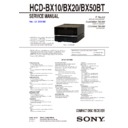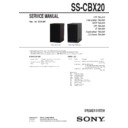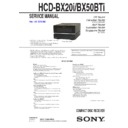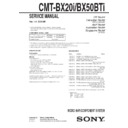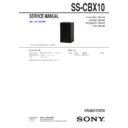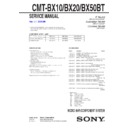Sony CMT-BX10 / CMT-BX20 / CMT-BX50BT / HCD-BX10 / HCD-BX20 / HCD-BX50BT Service Manual ▷ View online
SERVICE MANUAL
Sony Corporation
Audio&Video Business Group
Published by Sony Techno Create Corporation
HCD-BX10/BX20/BX50BT
SPECIFICATIONS
COMPACT DISC RECEIVER
9-889-105-04
2009B00-1
©
2009.02
E Model
HCD-BX10/BX20/BX50BT
Australian Model
HCD-BX10/BX50BT
Chinese Model
HCD-BX50BT
Ver. 1.3 2009.02
Model Name Using Similar Mechanism
NEW
Base Unit Name
BU-K6BD90-WOD
Optical Pick-up Block Name
KSM-213DCP
• HCD-BX10 is the amplifi er, CD player and
tuner section in CMT-BX10.
• HCD-BX20 is the amplifi er, CD player and
tuner section in CMT-BX20.
• HCD-BX50BT is the amplifi er, bluetooth, CD
player and tuner section in CMT-BX50BT.
Photo: HCD-BX50BT
• The Bluetooth word mark and logos are owned by the Bluetooth SIG, Inc.
and any use of such marks by Sony Corporation is under license. Other
trademarks and trade names are those of their respective owners.
trademarks and trade names are those of their respective owners.
• MPEG Layer-3 audio coding technology and patents licensed from
Fraunhofer IIS and Thomson.
DIN power output (rated):
18 + 18 W (6 ohms at 1 kHz, DIN)
18 + 18 W (6 ohms at 1 kHz, DIN)
DIN power output (rated):
18 + 18 W (6 ohms at 1 kHz, DIN)
18 + 18 W (6 ohms at 1 kHz, DIN)
Continuous RMS power output (reference): 25 + 25 W (6 ohms
at 1 kHz, 10% THD)
at 1 kHz, 10% THD)
Inputs
Inputs
Amplifier section (BX20)
Amplifier section (BX50BT)
(Except Chinese model)
(Chinese model)
AUDIO IN (stereo mini jack): voltage 250 mV, impedance 47
kilohms
kilohms
Outputs
Outputs
Bluetooth section (BX50BT)
PHONES (stereo mini jack): accepts headphones of 8 ohms or
more
SPEAKER: accepts impedance of 6 to 16 ohms
more
SPEAKER: accepts impedance of 6 to 16 ohms
CD player section
System: Compact disc and digital audio system
Laser Diode Properties
Laser Diode Properties
Emission Duration: Continuous
Laser Output*: Less than 44.6μW
* This output is the value measurement at a distance of 200mm
Laser Output*: Less than 44.6μW
* This output is the value measurement at a distance of 200mm
from the objective lens surface on the Optical Pick-up Block
with 7mm aperture.
with 7mm aperture.
Frequency response: 20 Hz – 20 kHz
Signal-to-noise ratio: More than 90 dB
Dynamic range: More than 90 dB
Signal-to-noise ratio: More than 90 dB
Dynamic range: More than 90 dB
Continuous RMS power output (reference): 25 + 25 watts
(6 ohms at 1 kHz, 10% THD)
(6 ohms at 1 kHz, 10% THD)
AUDIO IN (stereo mini jack): voltage250mV, impedance 47
kilohms
kilohms
PHONES (stereo mini jack): accepts headphones of 8 ohms or
more
SPEAKER: accepts impedance of 6 ohms
more
SPEAKER: accepts impedance of 6 ohms
Communication system: Bluetooth Standard version 2.0
Output: Bluetooth Standard Power Class 2
Output: Bluetooth Standard Power Class 2
Maximum communication range: Line of sight approx. 10 m
1)
Frequency band: 2.4 GHz band (2.4000 GHz – 2.4835GHz)
Modulation method: FHSS
Compatible Bluetooth profiles
2)
:
A2DP (Advanced Audio Distribution Profile)
AVRCP (Audio Video Remote Control Profile)
1)
The actual range will vary depending on factors such as
obstacles between devices, magnetic filds around a microwave
oven, static electricity, reception sensitivity, antenna’s
performance, operating system, software application, etc.
obstacles between devices, magnetic filds around a microwave
oven, static electricity, reception sensitivity, antenna’s
performance, operating system, software application, etc.
2)
Bluetooth standard profiles indicate the purpose of Bluetooth
communication between devices.
communication between devices.
Supported codecs:
Receive: SBC (Sub Band Codec), MP3
Transmit: SBC (Sub Band Codec)
Transmit: SBC (Sub Band Codec)
Amplifier section (BX10)
DIN power output (rated):
12 + 12 W (6 ohms at 1 kHz, DIN)
Continuous RMS power output (reference): 15 + 15 W (6 ohms
at 1 kHz, 10% THD)
12 + 12 W (6 ohms at 1 kHz, DIN)
Continuous RMS power output (reference): 15 + 15 W (6 ohms
at 1 kHz, 10% THD)
Inputs
AUDIO IN (stereo mini jack): voltage 250 mV, impedance
47 kilohms
47 kilohms
Outputs
PHONES (stereo mini jack): accepts headphones of 8 ohms or
more
SPEAKER: accepts impedance of 6 to 16 ohms
more
SPEAKER: accepts impedance of 6 to 16 ohms
General
Power requirements:
Taiwan model: 120 V AC, 50/60 Hz
Mexican model: 120 V AC, 60 Hz
Argentina model: 220 V AC, 50/60 Hz
Korean, Chinese models: 220 V AC, 50/60 Hz
Mexican model: 120 V AC, 60 Hz
Argentina model: 220 V AC, 50/60 Hz
Korean, Chinese models: 220 V AC, 50/60 Hz
Australian model: 230 – 240 V AC, 50/60 Hz
HCD-BX10: 45 watts
HCD-BX20/BX50BT: 56 watts
Power consumption:
Dimensions (w/h/d) (excl. speakers): Approx. 215 × 140 × 298 mm
M
M
Design and specifications are subject to change without notice.
ass (excl. speakers):Approx. 3.9 kg
Tunersection
FM stereo, FM/AM superheterodyne tuner
FM tuner section:
FM tuner section:
Tuning range: 87.5 – 108.0 MHz (50 kHz step)
Antenna: FM lead antenna
Antenna terminals: 75 ohms unbalanced
Intermediate frequency: 10.7 MHz
Antenna: FM lead antenna
Antenna terminals: 75 ohms unbalanced
Intermediate frequency: 10.7 MHz
AM tuner section:
Tuning range:
Latin American model:
530 – 1,710 kHz (with 10 kHz tuning interval)
531 – 1,710 kHz (with 9 kHz tuning interval)
530 – 1,710 kHz (with 10 kHz tuning interval)
531 – 1,710 kHz (with 9 kHz tuning interval)
Australian model:
531 – 1,710 kHz (with 10 kHz tuning interval)
530 – 1,710 kHz (with 9 kHz tuning interval)
531 – 1,710 kHz (with 10 kHz tuning interval)
530 – 1,710 kHz (with 9 kHz tuning interval)
Antenna: AM loop antenna, external antenna terminal
Intermediate frequency: 450 kHz
Intermediate frequency: 450 kHz
Other models:
531 – 1,602 kHz (with 9 kHz tuning interval)
530 – 1,610 kHz (with 10 kHz tuning interval)
531 – 1,602 kHz (with 9 kHz tuning interval)
530 – 1,610 kHz (with 10 kHz tuning interval)
Other models: 120 V, 220 V, 230 – 240 V AC, 50/60 Hz,
adjustable with voltage selector
adjustable with voltage selector
DIN power output (rated):
15 + 15 watts (6 ohms at 1 kHz, DIN)
Continuous RMS power output (reference): 20 + 20 watts
(6 ohms at 1 kHz, 10% THD)
15 + 15 watts (6 ohms at 1 kHz, DIN)
Continuous RMS power output (reference): 20 + 20 watts
(6 ohms at 1 kHz, 10% THD)
(Except Chinese model)
HCD-BX10/BX20/BX50BT
2
1.
SERVICING NOTES
............................................. 3
2. GENERAL
.................................................................. 5
3. DISASSEMBLY
3-1. Disassembly
Flow
........................................................... 7
3-2. Panel (Side L/R) .............................................................. 8
3-3. Top Panel Block .............................................................. 8
3-4. TOP KEY Board, Panel Top ........................................... 9
3-5. Front Panel Block ........................................................... 9
3-6. Rear Panel Block ............................................................ 10
3-7. Panel
3-3. Top Panel Block .............................................................. 8
3-4. TOP KEY Board, Panel Top ........................................... 9
3-5. Front Panel Block ........................................................... 9
3-6. Rear Panel Block ............................................................ 10
3-7. Panel
(Rear)
.................................................................... 10
3-8. AMP Board Block ........................................................... 11
3-9. POWER Board Block ..................................................... 11
3-10. MAIN Board ................................................................... 12
3-11. Loading Mechanism Block ............................................. 12
3-12. Base Unit ......................................................................... 13
3-13. Belt .................................................................................. 13
3-14. OP Base Assy (KSM-213D) ........................................... 14
3-9. POWER Board Block ..................................................... 11
3-10. MAIN Board ................................................................... 12
3-11. Loading Mechanism Block ............................................. 12
3-12. Base Unit ......................................................................... 13
3-13. Belt .................................................................................. 13
3-14. OP Base Assy (KSM-213D) ........................................... 14
4.
TEST MODE
............................................................ 15
5.
ELECTRICAL CHECKS
...................................... 17
6. DIAGRAMS
6-1. Block Diagram - CD SERVO Section - .......................... 19
6-2. Block Diagram - TUNER/BLUETOOTH Section - ....... 20
6-3. Block Diagram - MAIN Section - ................................... 21
6-4. Block
6-2. Block Diagram - TUNER/BLUETOOTH Section - ....... 20
6-3. Block Diagram - MAIN Section - ................................... 21
6-4. Block
Diagram
- PANEL/POWER SUPPLY Section - ............................ 22
6-5. Printed Wiring Boards - CD Section - ............................ 24
6-6. Schematic Diagram - CD Board - ................................... 25
6-7. Printed
6-6. Schematic Diagram - CD Board - ................................... 25
6-7. Printed
Wiring
Boards
- BLUETOOTH Section (BX50BT) - ............................. 26
6-8. Schematic
Diagram
- BLUETOOTH Section (BX50BT) - ............................. 27
6-9. Printed Wiring Boards - MAIN Section - ....................... 28
6-10. Schematic Diagram - MAIN Section (1/3) - ................... 29
6-11. Schematic Diagram - MAIN Section (2/3) - ................... 30
6-12. Schematic Diagram - MAIN Section (3/3) - ................... 31
6-13. Printed Wiring Boards
6-10. Schematic Diagram - MAIN Section (1/3) - ................... 29
6-11. Schematic Diagram - MAIN Section (2/3) - ................... 30
6-12. Schematic Diagram - MAIN Section (3/3) - ................... 31
6-13. Printed Wiring Boards
- AMP/HEADPHONE Section - ..................................... 32
6-14. Schematic Diagram - AMP/HEADPHONE Section - .... 33
6-15. Printed Wiring Boards - PANEL Section - ..................... 34
6-16. Schematic Diagram - PANEL Section - .......................... 35
6-17. Printed Wiring Boards - POWER Section - .................... 36
6-18. Schematic Diagram - POWER Section - ........................ 37
6-15. Printed Wiring Boards - PANEL Section - ..................... 34
6-16. Schematic Diagram - PANEL Section - .......................... 35
6-17. Printed Wiring Boards - POWER Section - .................... 36
6-18. Schematic Diagram - POWER Section - ........................ 37
7.
EXPLODED VIEWS
7-1. Panel
Section
................................................................... 44
7-2. Top Panel Section ........................................................... 45
7-3. Front Panel Section ......................................................... 46
7-4. MAIN Board Section ...................................................... 47
7-5. POWER Board Section ................................................... 48
7-6. Loading Mechanism Section .......................................... 49
7-7. Base Unit Section (BU-K6BD90-WOD) ....................... 50
7-3. Front Panel Section ......................................................... 46
7-4. MAIN Board Section ...................................................... 47
7-5. POWER Board Section ................................................... 48
7-6. Loading Mechanism Section .......................................... 49
7-7. Base Unit Section (BU-K6BD90-WOD) ....................... 50
8.
ELECTRICAL PARTS LIST
.............................. 51
TABLE OF CONTENTS
Notes on chip component replacement
•
•
Never reuse a disconnected chip component.
•
Notice that the minus side of a tantalum capacitor may be dam-
aged by heat.
aged by heat.
Flexible Circuit Board Repairing
•
•
Keep the temperature of soldering iron around 270 °C during
repairing.
repairing.
•
Do not touch the soldering iron on the same conductor of the
circuit board (within 3 times).
circuit board (within 3 times).
•
Be careful not to apply force on the conductor when soldering
or unsoldering.
or unsoldering.
SAFETY-RELATED COMPONET WARNING!
COMPONENTS IDENTIFIED BY MARK 0 OR DOTTED LINE
WITH MARK 0 ON THE SCHEMATIC DIAGRAMS AND IN
THE PARTS LIST ARE CRITICAL TO SAFE OPERATION.
REPLACE THESE COMPONENTS WITH SONY PARTS
WITH MARK 0 ON THE SCHEMATIC DIAGRAMS AND IN
THE PARTS LIST ARE CRITICAL TO SAFE OPERATION.
REPLACE THESE COMPONENTS WITH SONY PARTS
WHOSE PART NUMBERS APPEAR AS SHOWN IN THIS
MANUAL OR IN SUPPLEMENTS PUBLISHED BY SONY.
MANUAL OR IN SUPPLEMENTS PUBLISHED BY SONY.
CAUTION
Use of controls or adjustments or performance of procedures other than
those specifi ed herein may result in hazardous radiation exposure.
Use of controls or adjustments or performance of procedures other than
those specifi ed herein may result in hazardous radiation exposure.
This appliance is classifi ed as a
CLASS 1 LASER product.
This marking is located on the
rear or bottom exterior.
CLASS 1 LASER product.
This marking is located on the
rear or bottom exterior.
Ver. 1.1
仲♡⏰∄㉣⢋䗨䒌㆛旈⡺
㚐堩仒⯂ᷲ2䯟㼤₭濃DMBTT!2!
MBTFS濄ḋ␥Ɂ㚐㝫䫢ằᷲ倰曆⡺⡗
ᵮɁ
ᵮɁ
HCD-BX10/BX20/BX50BT
3
NOTES ON HANDLING THE OPTICAL PICK-UP
BLOCK OR BASE UNIT
BLOCK OR BASE UNIT
The laser diode in the optical pick-up block may suffer electrostat-
ic break-down because of the potential difference generated by the
charged electrostatic load, etc. on clothing and the human body.
During repair, pay attention to electrostatic break-down and also
use the procedure in the printed matter which is included in the
repair parts.
The fl exible board is easily damaged and should be handled with
care.
ic break-down because of the potential difference generated by the
charged electrostatic load, etc. on clothing and the human body.
During repair, pay attention to electrostatic break-down and also
use the procedure in the printed matter which is included in the
repair parts.
The fl exible board is easily damaged and should be handled with
care.
NOTES ON LASER DIODE EMISSION CHECK
The laser beam on this model is concentrated so as to be focused
on the disc refl ective surface by the objective lens in the optical
pickup block. Therefore, when checking the laser diode emission,
observe from more than 30 cm away from the objective lens.
The laser beam on this model is concentrated so as to be focused
on the disc refl ective surface by the objective lens in the optical
pickup block. Therefore, when checking the laser diode emission,
observe from more than 30 cm away from the objective lens.
UNLEADED SOLDER
Boards requiring use of unleaded solder are printed with the lead-
free mark (LF) indicating the solder contains no lead.
(Caution: Some printed circuit boards may not come printed with
Boards requiring use of unleaded solder are printed with the lead-
free mark (LF) indicating the solder contains no lead.
(Caution: Some printed circuit boards may not come printed with
the lead free mark due to their particular size)
: LEAD FREE MARK
Unleaded solder has the following characteristics.
• Unleaded solder melts at a temperature about 40 °C higher
• Unleaded solder melts at a temperature about 40 °C higher
than ordinary solder.
Ordinary soldering irons can be used but the iron tip has to be
applied to the solder joint for a slightly longer time.
applied to the solder joint for a slightly longer time.
Soldering irons using a temperature regulator should be set to
about 350 °C.
Caution: The printed pattern (copper foil) may peel away if the
about 350 °C.
Caution: The printed pattern (copper foil) may peel away if the
heated tip is applied for too long, so be careful!
• Strong
viscosity
Unleaded solder is more viscous (sticky, less prone to fl ow)
than ordinary solder so use caution not to let solder bridges
occur such as on IC pins, etc.
than ordinary solder so use caution not to let solder bridges
occur such as on IC pins, etc.
• Usable with ordinary solder
It is best to use only unleaded solder but unleaded solder may
also be added to ordinary solder.
also be added to ordinary solder.
SECTION 1
SERVICING NOTES
Model
Part No.
HCD-BX50BT: SP
3-295-840-0[]
HCD-BX50BT: AUS
3-295-841-0[]
HCD-BX50BT: TW
3-295-842-0[]
HCD-BX50BT: KR
3-295-843-0[]
HCD-BX50BT: CH
3-295-844-0[]
HCD-BX10: SP
3-295-851-0[]
HCD-BX10: AUS
3-295-852-0[]
HCD-BX10: KR
3-295-854-0[]
HCD-BX20: E2, E51
3-295-858-0[]
HCD-BX20: AR
3-295-862-0[]
HCD-BX10: TH
3-879-687-0[]
MODEL IDENTIFICATION
Part No.
Part No.
(BX10: AUS/BX20: AR/BX50BT: TW, AUS, CH)
(BX10: AUS/BX20: AR/BX50BT: TW, AUS, CH)
(BX10: KR, TH/BX50BT: KR)
– Rear View –
(BX10: KR, TH, AUS/BX20: AR/
BX50BT: TW, KR, AUS, CH)
(BX10: KR, TH, AUS/BX20: AR/
BX50BT: TW, KR, AUS, CH)
– Bottom View –
(BX10: SP/BX20: E2, E51/BX50BT: SP)
(BX10: SP/BX20: E2, E51/BX50BT: SP)
Part No.
Part No.
(BX50BT: SP)
(BX10: SP/BX20: E2, E51)
• Abbreviation
AR :
AR :
Argentina
model
AUS :
Australian
model
CH :
Chinese
model
E2
: 120V AC area in E model
E51
: Chilean and Peruvian models
KR
: Korean model
SP
: Singapore model
TH :
Thai
model
TW :
Taiwan
model
ANTITHEFT UNLOCK MODE
Procedure:
1. Press the [
Procedure:
1. Press the [
?/1
] button to turn the power on.
2. Press the [FUNCTION] button to select “CD”.
3. Press two buttons of [
3. Press two buttons of [
x/
CANCEL] and [
A
] for 5 seconds.
4. The message “UNLOCKED” is displayed on the fl uorescent
indicator tube and the disc tray is unlocked.
Note: When “LOCKED” is displayed, the tray lock is not released by
turning power on/off with the [?/1] button.
NOTE OF REPLACING THE IC904 ON THE BT BOARD
IC904 on the BT board cannot exchange with single. When IC904
on the BT board is damaged, exchange the entire mounted board.
IC904 on the BT board cannot exchange with single. When IC904
on the BT board is damaged, exchange the entire mounted board.
Ver. 1.1
HCD-BX10/BX20/BX50BT
4
HOW TO OPEN THE TRAY WHEN POWER SWITCH TURN OFF
Note: Please insert a screwdriver after removing the panel (side L).
About disassembly of the panel (side L), please refer to “3-2. Panel (Side L/R)” (page 8).
Open the tray.
Push the boss.
Insert the driver.

